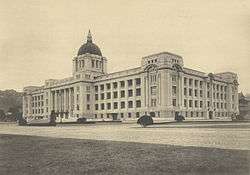Governor-General of Korea
| Governor-General of Korea | |
 General-Government building, Seoul | |
| Korean name | |
|---|---|
| Hangul | 조선총독 |
| Hanja | 朝鮮總督 |
| Revised Romanization | Joseon Chongdok |
| McCune–Reischauer | Chosŏn Ch'ongdok |
|
Japanese name: Chōsen Sōtoku (朝鮮総督) | |
The post of Governor-General of Korea served as the chief administrator of Korea while it was held as Chōsen from 1910 to 1945. The seat of the colonial government was the General Government Building, completed in 1926.[1]
History
After the annexation of Korea to Japan in 1910, the office of Resident-General was replaced by that of Governor-General. However, the position was unique in among Japan's external possessions, as the Governor-General had sweeping plenipotentiary powers, and the position also entailed judicial oversight and some legislative powers. As of 1944, the Governor-General did not command the Imperial Japanese Army or Imperial Japanese Navy units stationed in Korea.[2] Given the powers and levels of responsibility, only ranking full generals in the Japanese Army were selected for the post (with the sole exception of retired admiral Saitō Makoto).
After the Japanese defeat in World War II, the Korean Peninsula was administrated by the Democratic People's Republic of Korea and the Republic of Korea. The Governor-General building was completely demolished during administration of South Korean president Kim Yong-Sam on August 15, 1995.
Prime Ministers of Japan
Four individuals who held the position of the Governor-General of Korea also held the office of the Prime Minister of Japan. Three, Terauchi Masatake, Saitō Makoto, and Koiso Kuniaki, were Governors-General before becoming Prime Ministers. One, Abe Nobuyuki, was Prime Minister before his appointment as Governor-General. Ugaki Kazushige was named Prime Minister-designate, but he could not take office because he was unable to form a cabinet.
In addition, Resident-General Itō Hirobumi served four terms as Prime Minister prior to his appointment to Korea.
Residents-General
.svg.png)
From 1906 to 1910, Korean Empire became a protectorate of Japan and Japan was represented by a Resident-General in the Korean Empire.
- Prince Itō Hirobumi (1905–1909)
- Viscount Sone Arasuke (1909)
- General Viscount Terauchi Masatake (1909–1910)
Governors-General
After the annexation of Korea to Japan in 1910, the office of Resident General was replaced by that of Governor-General.
- General Count Terauchi Masatake 寺内 正毅 (1910–1916)
- Gensui Count Hasegawa Yoshimichi 長谷川好道 (1916–1919)
- Admiral Viscount Saitō Makoto 斎藤 実 (1919–1927)
- General Ugaki Kazushige 宇垣 一成 (1927)
- General Yamanashi Hanzō 山梨半造, (1927–1929)
- Viscount Saitō Makoto 斎藤 実 (second time 1929–1931)
- General Ugaki Kazushige 宇垣 一成 (second time 1931–1936)
- General Minami Jirō 南次郎 (1936–1942)
- General (ret'd) Koiso Kuniaki 小磯 國昭 (1942–1944)
- General (ret'd) Abe Nobuyuki 阿部信行 (1944–1945)
See also
- Governor-General of Taiwan
- Rulers of Korea
- Anti-Japanese sentiment in Korea
- Japanese militarism
- Japanese nationalism
References
- Kim, Djun (2005). The History of Korea. Greenwood Press. ISBN 0-313-33296-7.
- ↑ The building was completely destroyed during administration of South Korean president King Yong-sam on August 15, 1995.
- ↑ Grajdanzev, Andrew (2007). "The Government of Korea". Modern Korea (2 ed.). Orchard Press. p. 238. ISBN 978-1-4067-3825-4.